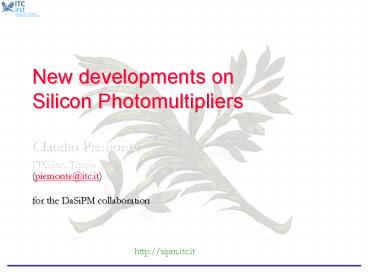sipm - PowerPoint PPT Presentation
1 / 18
Title: sipm
1
New developments on Silicon Photomultipliers Cl
audio Piemonte ITC-irst, Trento
(piemonte_at_itc.it) for the DaSiPM collaboration
http//sipm.itc.it
2
The project
- Development and application of SiPMs is a joint
- collaboration between IRST (Trento) and INFN.
- IRST
- development of the technology for the
production of SiPMs - (large area devices/matrices) functional
characterization - INFN (Pisa, Bari, Bologna, Perugia, Trento
spokesman Alberto Del Guerra) - development of systems, with optimized read-out
electronics, - based on SiPMs for applications such as
- - tracking with scintillating fibers
- - PET
- - TOF
- - calorimetry
- In this presentation I will talk about the
status of the device
3
IRST technology
C. Piemonte A new Silicon Photomultiplier
structure for blue light detection NIMA 568
(2006)
Shallow-Junction SiPM
Standard approach but with two peculiarities
1) Very shallow junction 2) ARC optimized for
short wavelenghts So far, 3 batches have been
produced with this technology.
To enhance QE at short wavel.
4
SiPM geometry
Todays basic structure - 25x25 cells -
microcell size 40x40mm2
1mm
1mm
Geometry NOT yet optimized for maximum PDE
(current max fill factor 30)
5
Tests performed so far
- Reverse IV measurement
- fast test to verify functionality and
uniformity of the properties. - (Performed on more than 1000 devices
- coming from 3 different batches)
- Dynamic characterization in dark
- for a complete characterization of the output
signal and - noise properties (signal shape, gain, dark
count, optical cross-talk, after-pulse) - (performed on 100 devices, coming from 2
different batches) - Photodetection efficiency
- Energy resolution of SiPM coupled with LSO (INFN
Pisa) - Timing performance (INFN Pisa)
6
Static characteristic
T22oC
Reverse Current around the breakdown voltage
Breakdown current Measured current - Leakage
current
Leakage current mainly due to surface
generation at the micro-diode
periphery (linear fit) Breakdown current
determined by dark events
Gain linear with VBIAS
IBD parabola
Dark count linear with VBIAS
7
Static characteristic (2)
- So, the reverse characteristic gives information
on - Breakdown voltage value
- Dark count rate level
Example one wafer from the last production
1) ActiveArea1 gt ActiveArea2 DC1
gt DC2 2) Uniform Gain and Dark count rate.
Breakdown uniformity at the level of s0.4V
For different batches IBD is uniform while max
VBD spread 2/3V
8
Signal properties
Typologies of pulses.
Av 100x
s single d double pulses a after-pulse
9
Gain Dark count
Gain vs Bias voltage
T22oC
- QCmicrocell(Vbias-Vbreakdown)
- C 80-90fF
- Very uniform from device to
- device
Dark count vs Bias voltage (typical)
tgen 10ms It increases linearly
because the triggering probability grows linearly
with bias
10
Photodetection efficiency
Area efficiency 20
0.16 0.14 0.12 0.10 0.08 0.06 0.04 0.02 0
Why this shape?
PDEQEPtAe
PDE
QEquantum eff. Ptavalanche prob. Aearea eff.
350 400 450 500 550 600
650 700 750 800
QE vs Wavelength
Measured on a diode
11
Single-cell charge resolution
Blue pulsed laser 3V over-voltage
Counts
ADC
12
SiPM Scintillator
PRELIMINARY
SiPM fill factor 20
- Measurement set up
- 1x1mm2 SiPM
- 1x1x10mm3 LSO
- scintillator (lpeak420nm)
- LSO positioned directly
- on the SiPM
- 22Na source emitting
- g at 511keV
- coincidence with a
- second SiPM
- 1) Set up to be optimized!
- 2) Fill factor to be optimized!
ResFWHM 29
New tests on 2x2 matrices are ongoing
SiPM fill factor 30
ResFWHM 21
13
Timing performance
PRELIMINARY
- Laser - wavelength 400 or 800nm
- - pulse width 60fs
- - pulse period 12.34ns with time
jitter lt100fs - Filters to have 1 photodetection/laser pulse
- SiPMs 3 devices from 2 different batches
measured
1. More statistics needed 2. New tests
planned by the end of the year.
timing sigma (ps)
overvoltage (V)
14
Conclusion
- We have been working on SiPMs (GM-APDs) for less
- than 2 years obtaining very good results
- - devices working properly
- - very good performance reproducibility
- - good yield
- - extremely good understanding of the device.
- Next steps
- - technology SiPMs with lower dark count
- - layout 1) optimization of the fill factor
- 2) larger areas/ matrices
already designed
15
BACK-UP SLIDES
16
Optical cross-talk
Remainder
3x10-5 photons with energy higher than 1.14eV
emitted per carrier crossing the Junction in BD
condition. A.
Lacaita et al., IEEE TED, vol. 40, n. 3, 1993
gt 2 or more cells can be activated at the same
time per event
Optical cross-talk can be characterized using a
very short integration time (e.g. 10ns)
Devices with trenches (produced by us) have a
much lower cross-talk but higher dark count rate
(twice) (process improvement needed)
17
After-pulse
Events with after-pulse measured on a single
micropixel.
The amplitude of the after-pulse increases as the
cell recovers to its opertional condition
After-pulse probability vs bias
It increases following a parabolic law
linear with Vbias
linear with Vbias
18
VBD Temperature dependence
Pulse amplitude vs Bias voltage at 6
temperatures
Breakdown voltage vs Temp.
80mV/K 0.27/K































